A Comprehensive Analysis: Negative Impacts of Tourism on Environments
VerifiedAdded on 2020/11/23
|7
|2131
|152
Essay
AI Summary
This essay provides a comprehensive analysis of the negative environmental impacts of the tourism industry. It explores various detrimental effects, including noise pollution from transportation, waste disposal issues in popular destinations, and environmental degradation stemming from increased resource usage and habitat loss. The essay highlights how tourism contributes to water pollution, soil erosion, and the endangerment of species. It also examines economic and social consequences, such as seasonal job markets and price increases for locals. The essay emphasizes the importance of addressing these issues through sustainable tourism practices to protect the environment and ensure the long-term viability of the industry. The essay uses various sources to support its claims and concludes with a call for action to mitigate these negative impacts. The essay also touches upon the impact of tourism on essential resources and the effects of construction and recreation on the environment. You can find similar essays and solutions on Desklib.
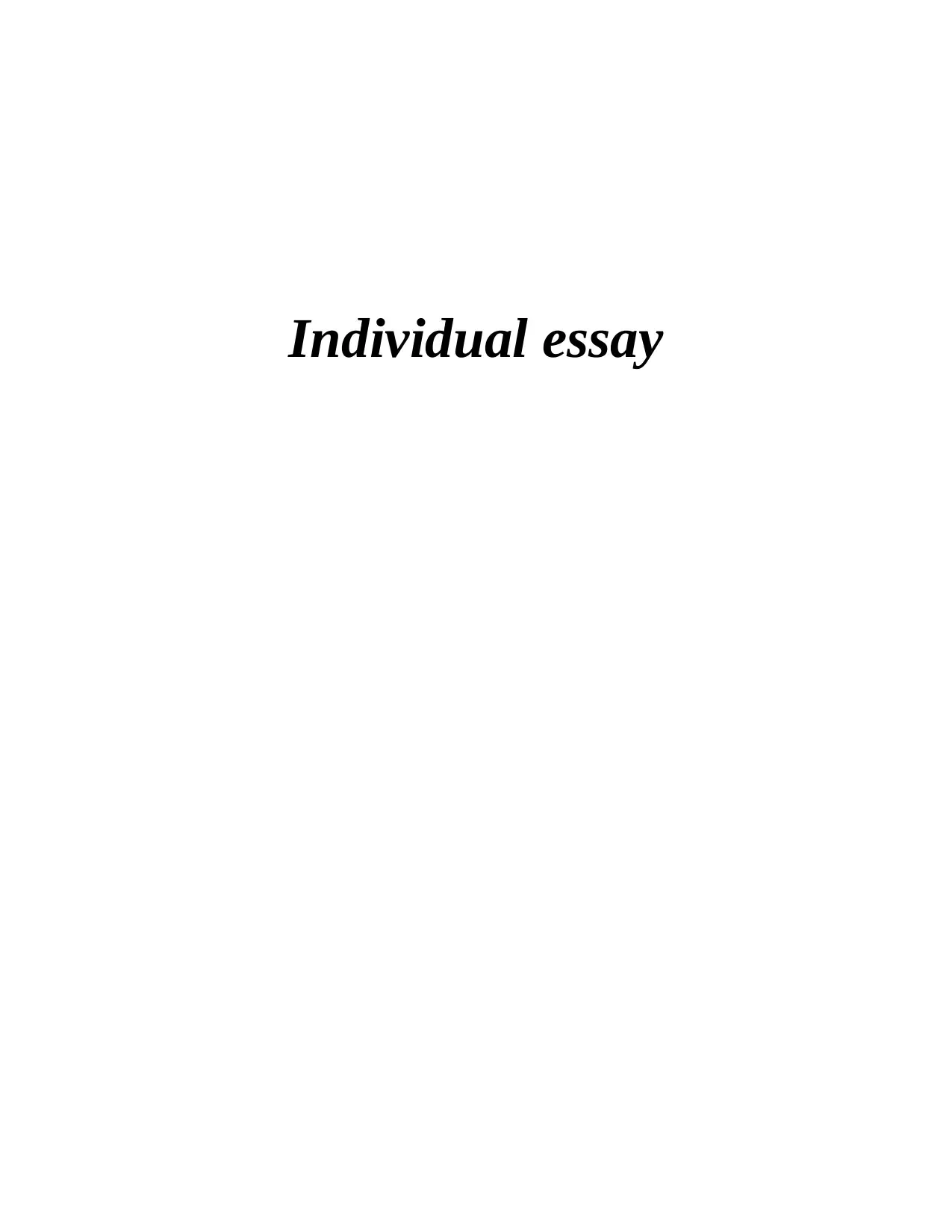
Individual essay
Paraphrase This Document
Need a fresh take? Get an instant paraphrase of this document with our AI Paraphraser
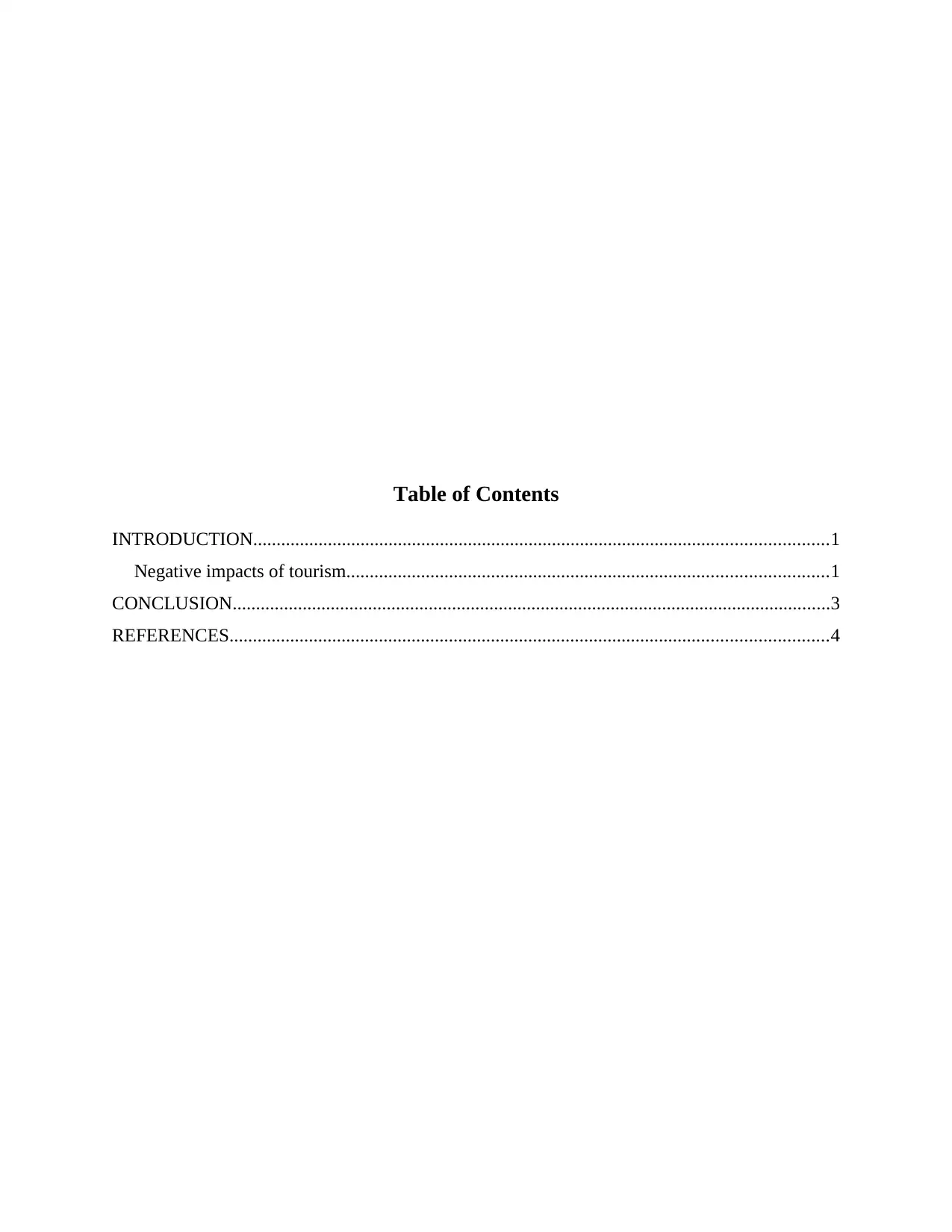
Table of Contents
INTRODUCTION...........................................................................................................................1
Negative impacts of tourism.......................................................................................................1
CONCLUSION................................................................................................................................3
REFERENCES................................................................................................................................4
INTRODUCTION...........................................................................................................................1
Negative impacts of tourism.......................................................................................................1
CONCLUSION................................................................................................................................3
REFERENCES................................................................................................................................4
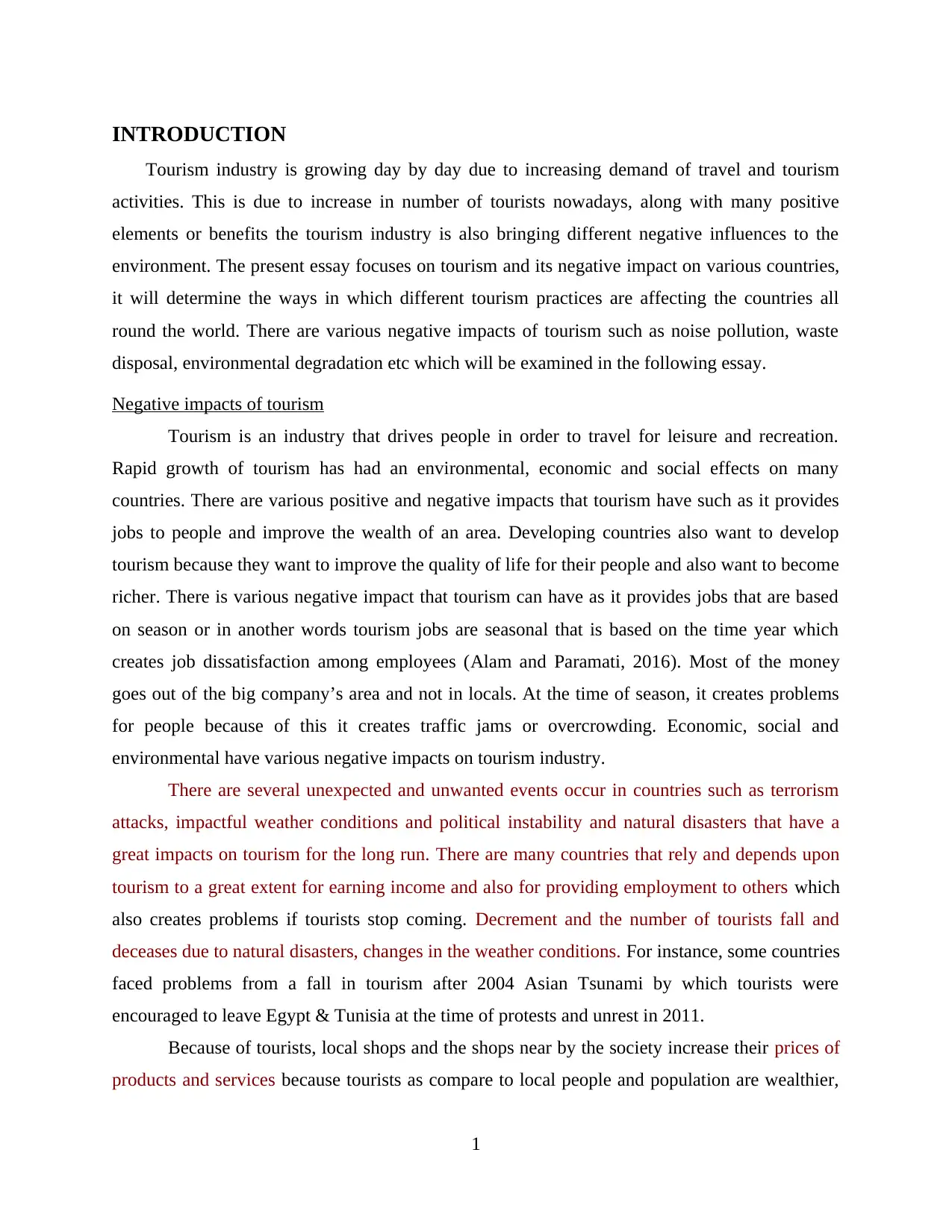
INTRODUCTION
Tourism industry is growing day by day due to increasing demand of travel and tourism
activities. This is due to increase in number of tourists nowadays, along with many positive
elements or benefits the tourism industry is also bringing different negative influences to the
environment. The present essay focuses on tourism and its negative impact on various countries,
it will determine the ways in which different tourism practices are affecting the countries all
round the world. There are various negative impacts of tourism such as noise pollution, waste
disposal, environmental degradation etc which will be examined in the following essay.
Negative impacts of tourism
Tourism is an industry that drives people in order to travel for leisure and recreation.
Rapid growth of tourism has had an environmental, economic and social effects on many
countries. There are various positive and negative impacts that tourism have such as it provides
jobs to people and improve the wealth of an area. Developing countries also want to develop
tourism because they want to improve the quality of life for their people and also want to become
richer. There is various negative impact that tourism can have as it provides jobs that are based
on season or in another words tourism jobs are seasonal that is based on the time year which
creates job dissatisfaction among employees (Alam and Paramati, 2016). Most of the money
goes out of the big company’s area and not in locals. At the time of season, it creates problems
for people because of this it creates traffic jams or overcrowding. Economic, social and
environmental have various negative impacts on tourism industry.
There are several unexpected and unwanted events occur in countries such as terrorism
attacks, impactful weather conditions and political instability and natural disasters that have a
great impacts on tourism for the long run. There are many countries that rely and depends upon
tourism to a great extent for earning income and also for providing employment to others which
also creates problems if tourists stop coming. Decrement and the number of tourists fall and
deceases due to natural disasters, changes in the weather conditions. For instance, some countries
faced problems from a fall in tourism after 2004 Asian Tsunami by which tourists were
encouraged to leave Egypt & Tunisia at the time of protests and unrest in 2011.
Because of tourists, local shops and the shops near by the society increase their prices of
products and services because tourists as compare to local people and population are wealthier,
1
Tourism industry is growing day by day due to increasing demand of travel and tourism
activities. This is due to increase in number of tourists nowadays, along with many positive
elements or benefits the tourism industry is also bringing different negative influences to the
environment. The present essay focuses on tourism and its negative impact on various countries,
it will determine the ways in which different tourism practices are affecting the countries all
round the world. There are various negative impacts of tourism such as noise pollution, waste
disposal, environmental degradation etc which will be examined in the following essay.
Negative impacts of tourism
Tourism is an industry that drives people in order to travel for leisure and recreation.
Rapid growth of tourism has had an environmental, economic and social effects on many
countries. There are various positive and negative impacts that tourism have such as it provides
jobs to people and improve the wealth of an area. Developing countries also want to develop
tourism because they want to improve the quality of life for their people and also want to become
richer. There is various negative impact that tourism can have as it provides jobs that are based
on season or in another words tourism jobs are seasonal that is based on the time year which
creates job dissatisfaction among employees (Alam and Paramati, 2016). Most of the money
goes out of the big company’s area and not in locals. At the time of season, it creates problems
for people because of this it creates traffic jams or overcrowding. Economic, social and
environmental have various negative impacts on tourism industry.
There are several unexpected and unwanted events occur in countries such as terrorism
attacks, impactful weather conditions and political instability and natural disasters that have a
great impacts on tourism for the long run. There are many countries that rely and depends upon
tourism to a great extent for earning income and also for providing employment to others which
also creates problems if tourists stop coming. Decrement and the number of tourists fall and
deceases due to natural disasters, changes in the weather conditions. For instance, some countries
faced problems from a fall in tourism after 2004 Asian Tsunami by which tourists were
encouraged to leave Egypt & Tunisia at the time of protests and unrest in 2011.
Because of tourists, local shops and the shops near by the society increase their prices of
products and services because tourists as compare to local people and population are wealthier,
1
⊘ This is a preview!⊘
Do you want full access?
Subscribe today to unlock all pages.

Trusted by 1+ million students worldwide
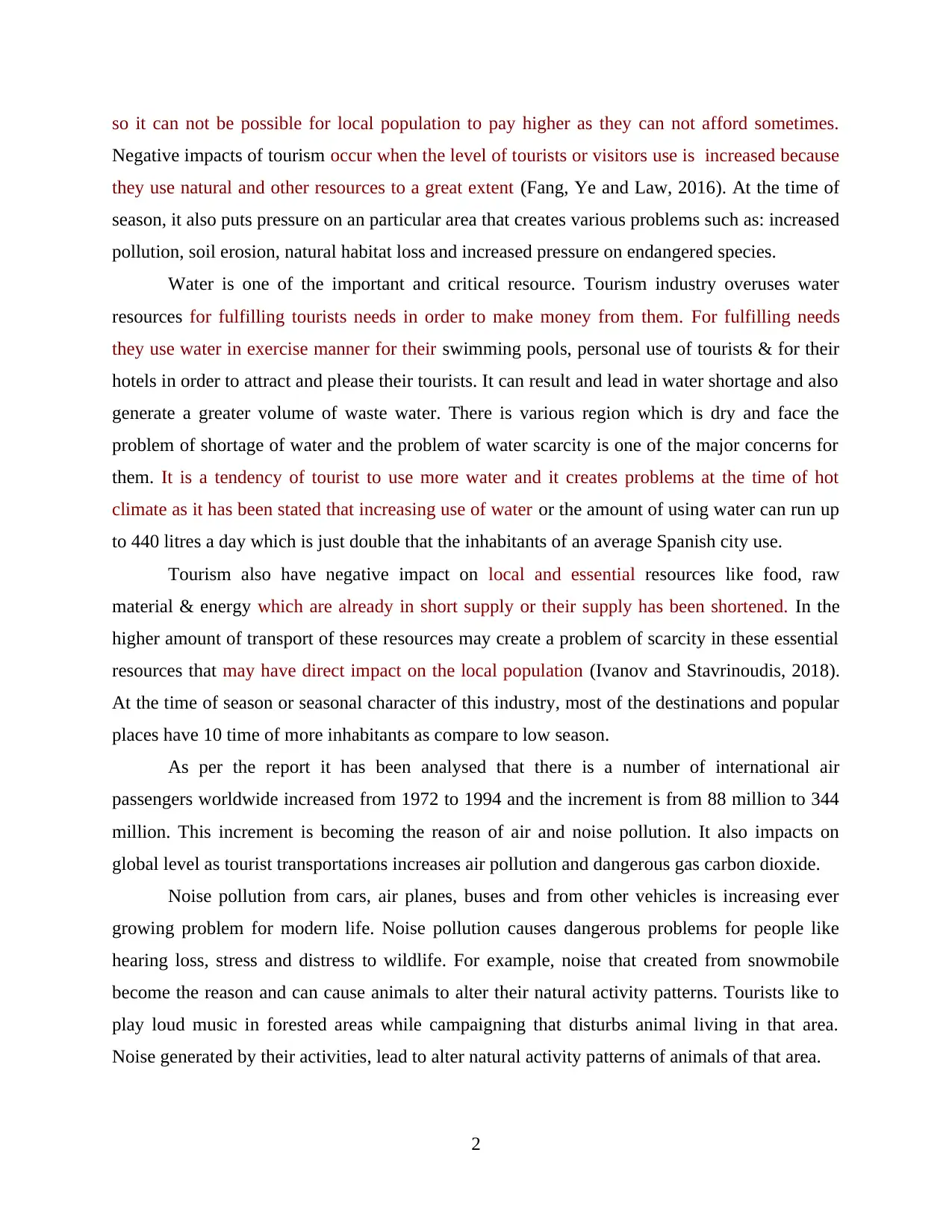
so it can not be possible for local population to pay higher as they can not afford sometimes.
Negative impacts of tourism occur when the level of tourists or visitors use is increased because
they use natural and other resources to a great extent (Fang, Ye and Law, 2016). At the time of
season, it also puts pressure on an particular area that creates various problems such as: increased
pollution, soil erosion, natural habitat loss and increased pressure on endangered species.
Water is one of the important and critical resource. Tourism industry overuses water
resources for fulfilling tourists needs in order to make money from them. For fulfilling needs
they use water in exercise manner for their swimming pools, personal use of tourists & for their
hotels in order to attract and please their tourists. It can result and lead in water shortage and also
generate a greater volume of waste water. There is various region which is dry and face the
problem of shortage of water and the problem of water scarcity is one of the major concerns for
them. It is a tendency of tourist to use more water and it creates problems at the time of hot
climate as it has been stated that increasing use of water or the amount of using water can run up
to 440 litres a day which is just double that the inhabitants of an average Spanish city use.
Tourism also have negative impact on local and essential resources like food, raw
material & energy which are already in short supply or their supply has been shortened. In the
higher amount of transport of these resources may create a problem of scarcity in these essential
resources that may have direct impact on the local population (Ivanov and Stavrinoudis, 2018).
At the time of season or seasonal character of this industry, most of the destinations and popular
places have 10 time of more inhabitants as compare to low season.
As per the report it has been analysed that there is a number of international air
passengers worldwide increased from 1972 to 1994 and the increment is from 88 million to 344
million. This increment is becoming the reason of air and noise pollution. It also impacts on
global level as tourist transportations increases air pollution and dangerous gas carbon dioxide.
Noise pollution from cars, air planes, buses and from other vehicles is increasing ever
growing problem for modern life. Noise pollution causes dangerous problems for people like
hearing loss, stress and distress to wildlife. For example, noise that created from snowmobile
become the reason and can cause animals to alter their natural activity patterns. Tourists like to
play loud music in forested areas while campaigning that disturbs animal living in that area.
Noise generated by their activities, lead to alter natural activity patterns of animals of that area.
2
Negative impacts of tourism occur when the level of tourists or visitors use is increased because
they use natural and other resources to a great extent (Fang, Ye and Law, 2016). At the time of
season, it also puts pressure on an particular area that creates various problems such as: increased
pollution, soil erosion, natural habitat loss and increased pressure on endangered species.
Water is one of the important and critical resource. Tourism industry overuses water
resources for fulfilling tourists needs in order to make money from them. For fulfilling needs
they use water in exercise manner for their swimming pools, personal use of tourists & for their
hotels in order to attract and please their tourists. It can result and lead in water shortage and also
generate a greater volume of waste water. There is various region which is dry and face the
problem of shortage of water and the problem of water scarcity is one of the major concerns for
them. It is a tendency of tourist to use more water and it creates problems at the time of hot
climate as it has been stated that increasing use of water or the amount of using water can run up
to 440 litres a day which is just double that the inhabitants of an average Spanish city use.
Tourism also have negative impact on local and essential resources like food, raw
material & energy which are already in short supply or their supply has been shortened. In the
higher amount of transport of these resources may create a problem of scarcity in these essential
resources that may have direct impact on the local population (Ivanov and Stavrinoudis, 2018).
At the time of season or seasonal character of this industry, most of the destinations and popular
places have 10 time of more inhabitants as compare to low season.
As per the report it has been analysed that there is a number of international air
passengers worldwide increased from 1972 to 1994 and the increment is from 88 million to 344
million. This increment is becoming the reason of air and noise pollution. It also impacts on
global level as tourist transportations increases air pollution and dangerous gas carbon dioxide.
Noise pollution from cars, air planes, buses and from other vehicles is increasing ever
growing problem for modern life. Noise pollution causes dangerous problems for people like
hearing loss, stress and distress to wildlife. For example, noise that created from snowmobile
become the reason and can cause animals to alter their natural activity patterns. Tourists like to
play loud music in forested areas while campaigning that disturbs animal living in that area.
Noise generated by their activities, lead to alter natural activity patterns of animals of that area.
2
Paraphrase This Document
Need a fresh take? Get an instant paraphrase of this document with our AI Paraphraser
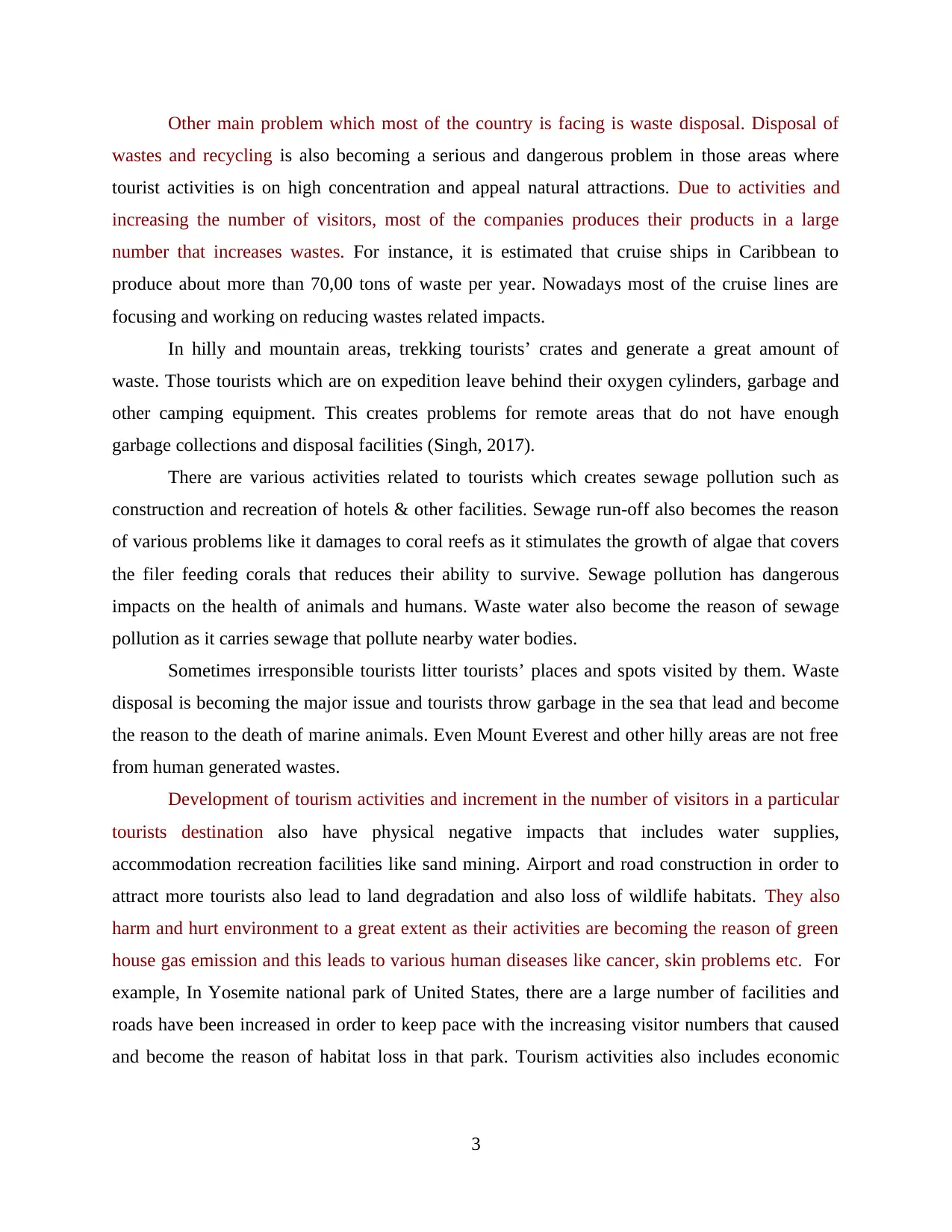
Other main problem which most of the country is facing is waste disposal. Disposal of
wastes and recycling is also becoming a serious and dangerous problem in those areas where
tourist activities is on high concentration and appeal natural attractions. Due to activities and
increasing the number of visitors, most of the companies produces their products in a large
number that increases wastes. For instance, it is estimated that cruise ships in Caribbean to
produce about more than 70,00 tons of waste per year. Nowadays most of the cruise lines are
focusing and working on reducing wastes related impacts.
In hilly and mountain areas, trekking tourists’ crates and generate a great amount of
waste. Those tourists which are on expedition leave behind their oxygen cylinders, garbage and
other camping equipment. This creates problems for remote areas that do not have enough
garbage collections and disposal facilities (Singh, 2017).
There are various activities related to tourists which creates sewage pollution such as
construction and recreation of hotels & other facilities. Sewage run-off also becomes the reason
of various problems like it damages to coral reefs as it stimulates the growth of algae that covers
the filer feeding corals that reduces their ability to survive. Sewage pollution has dangerous
impacts on the health of animals and humans. Waste water also become the reason of sewage
pollution as it carries sewage that pollute nearby water bodies.
Sometimes irresponsible tourists litter tourists’ places and spots visited by them. Waste
disposal is becoming the major issue and tourists throw garbage in the sea that lead and become
the reason to the death of marine animals. Even Mount Everest and other hilly areas are not free
from human generated wastes.
Development of tourism activities and increment in the number of visitors in a particular
tourists destination also have physical negative impacts that includes water supplies,
accommodation recreation facilities like sand mining. Airport and road construction in order to
attract more tourists also lead to land degradation and also loss of wildlife habitats. They also
harm and hurt environment to a great extent as their activities are becoming the reason of green
house gas emission and this leads to various human diseases like cancer, skin problems etc. For
example, In Yosemite national park of United States, there are a large number of facilities and
roads have been increased in order to keep pace with the increasing visitor numbers that caused
and become the reason of habitat loss in that park. Tourism activities also includes economic
3
wastes and recycling is also becoming a serious and dangerous problem in those areas where
tourist activities is on high concentration and appeal natural attractions. Due to activities and
increasing the number of visitors, most of the companies produces their products in a large
number that increases wastes. For instance, it is estimated that cruise ships in Caribbean to
produce about more than 70,00 tons of waste per year. Nowadays most of the cruise lines are
focusing and working on reducing wastes related impacts.
In hilly and mountain areas, trekking tourists’ crates and generate a great amount of
waste. Those tourists which are on expedition leave behind their oxygen cylinders, garbage and
other camping equipment. This creates problems for remote areas that do not have enough
garbage collections and disposal facilities (Singh, 2017).
There are various activities related to tourists which creates sewage pollution such as
construction and recreation of hotels & other facilities. Sewage run-off also becomes the reason
of various problems like it damages to coral reefs as it stimulates the growth of algae that covers
the filer feeding corals that reduces their ability to survive. Sewage pollution has dangerous
impacts on the health of animals and humans. Waste water also become the reason of sewage
pollution as it carries sewage that pollute nearby water bodies.
Sometimes irresponsible tourists litter tourists’ places and spots visited by them. Waste
disposal is becoming the major issue and tourists throw garbage in the sea that lead and become
the reason to the death of marine animals. Even Mount Everest and other hilly areas are not free
from human generated wastes.
Development of tourism activities and increment in the number of visitors in a particular
tourists destination also have physical negative impacts that includes water supplies,
accommodation recreation facilities like sand mining. Airport and road construction in order to
attract more tourists also lead to land degradation and also loss of wildlife habitats. They also
harm and hurt environment to a great extent as their activities are becoming the reason of green
house gas emission and this leads to various human diseases like cancer, skin problems etc. For
example, In Yosemite national park of United States, there are a large number of facilities and
roads have been increased in order to keep pace with the increasing visitor numbers that caused
and become the reason of habitat loss in that park. Tourism activities also includes economic
3
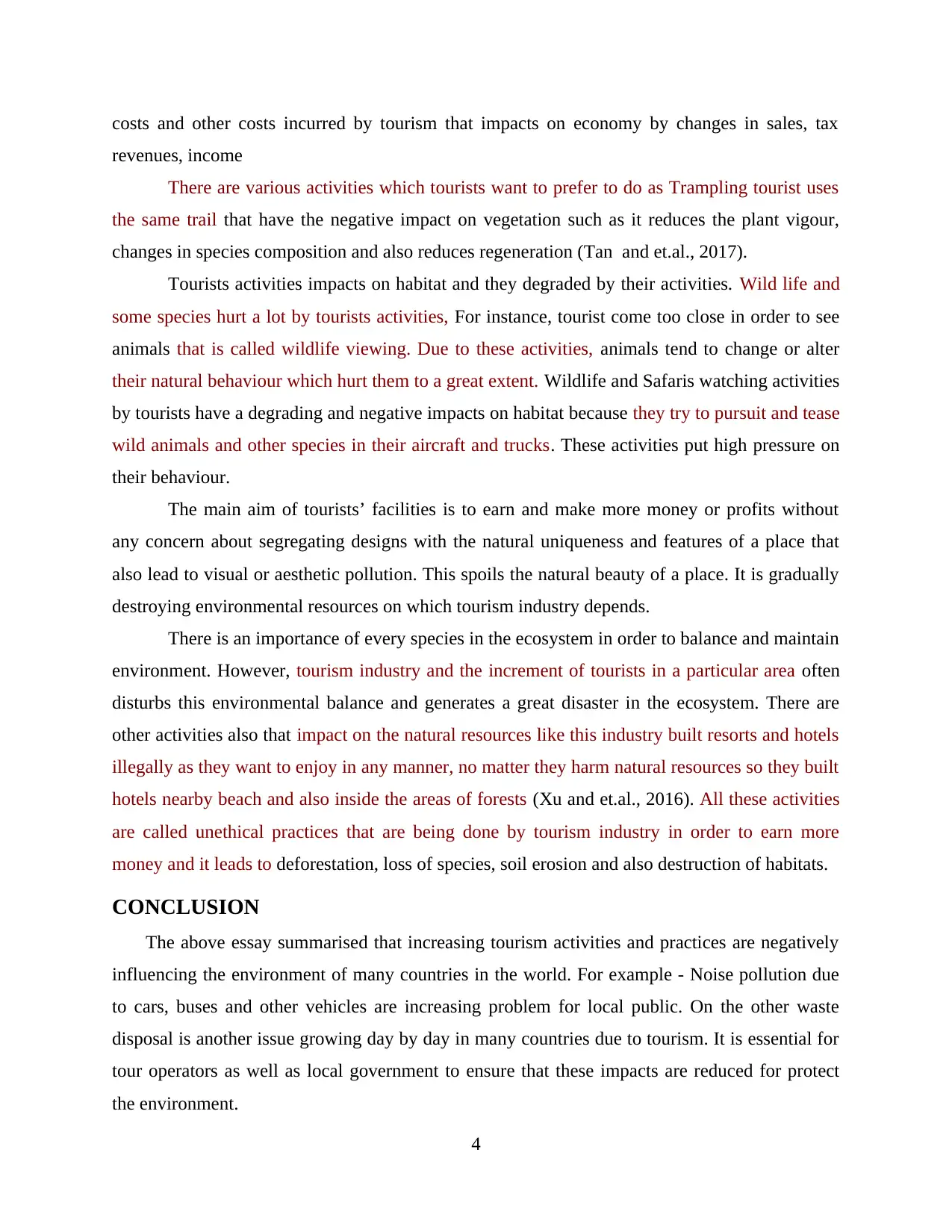
costs and other costs incurred by tourism that impacts on economy by changes in sales, tax
revenues, income
There are various activities which tourists want to prefer to do as Trampling tourist uses
the same trail that have the negative impact on vegetation such as it reduces the plant vigour,
changes in species composition and also reduces regeneration (Tan and et.al., 2017).
Tourists activities impacts on habitat and they degraded by their activities. Wild life and
some species hurt a lot by tourists activities, For instance, tourist come too close in order to see
animals that is called wildlife viewing. Due to these activities, animals tend to change or alter
their natural behaviour which hurt them to a great extent. Wildlife and Safaris watching activities
by tourists have a degrading and negative impacts on habitat because they try to pursuit and tease
wild animals and other species in their aircraft and trucks. These activities put high pressure on
their behaviour.
The main aim of tourists’ facilities is to earn and make more money or profits without
any concern about segregating designs with the natural uniqueness and features of a place that
also lead to visual or aesthetic pollution. This spoils the natural beauty of a place. It is gradually
destroying environmental resources on which tourism industry depends.
There is an importance of every species in the ecosystem in order to balance and maintain
environment. However, tourism industry and the increment of tourists in a particular area often
disturbs this environmental balance and generates a great disaster in the ecosystem. There are
other activities also that impact on the natural resources like this industry built resorts and hotels
illegally as they want to enjoy in any manner, no matter they harm natural resources so they built
hotels nearby beach and also inside the areas of forests (Xu and et.al., 2016). All these activities
are called unethical practices that are being done by tourism industry in order to earn more
money and it leads to deforestation, loss of species, soil erosion and also destruction of habitats.
CONCLUSION
The above essay summarised that increasing tourism activities and practices are negatively
influencing the environment of many countries in the world. For example - Noise pollution due
to cars, buses and other vehicles are increasing problem for local public. On the other waste
disposal is another issue growing day by day in many countries due to tourism. It is essential for
tour operators as well as local government to ensure that these impacts are reduced for protect
the environment.
4
revenues, income
There are various activities which tourists want to prefer to do as Trampling tourist uses
the same trail that have the negative impact on vegetation such as it reduces the plant vigour,
changes in species composition and also reduces regeneration (Tan and et.al., 2017).
Tourists activities impacts on habitat and they degraded by their activities. Wild life and
some species hurt a lot by tourists activities, For instance, tourist come too close in order to see
animals that is called wildlife viewing. Due to these activities, animals tend to change or alter
their natural behaviour which hurt them to a great extent. Wildlife and Safaris watching activities
by tourists have a degrading and negative impacts on habitat because they try to pursuit and tease
wild animals and other species in their aircraft and trucks. These activities put high pressure on
their behaviour.
The main aim of tourists’ facilities is to earn and make more money or profits without
any concern about segregating designs with the natural uniqueness and features of a place that
also lead to visual or aesthetic pollution. This spoils the natural beauty of a place. It is gradually
destroying environmental resources on which tourism industry depends.
There is an importance of every species in the ecosystem in order to balance and maintain
environment. However, tourism industry and the increment of tourists in a particular area often
disturbs this environmental balance and generates a great disaster in the ecosystem. There are
other activities also that impact on the natural resources like this industry built resorts and hotels
illegally as they want to enjoy in any manner, no matter they harm natural resources so they built
hotels nearby beach and also inside the areas of forests (Xu and et.al., 2016). All these activities
are called unethical practices that are being done by tourism industry in order to earn more
money and it leads to deforestation, loss of species, soil erosion and also destruction of habitats.
CONCLUSION
The above essay summarised that increasing tourism activities and practices are negatively
influencing the environment of many countries in the world. For example - Noise pollution due
to cars, buses and other vehicles are increasing problem for local public. On the other waste
disposal is another issue growing day by day in many countries due to tourism. It is essential for
tour operators as well as local government to ensure that these impacts are reduced for protect
the environment.
4
⊘ This is a preview!⊘
Do you want full access?
Subscribe today to unlock all pages.

Trusted by 1+ million students worldwide
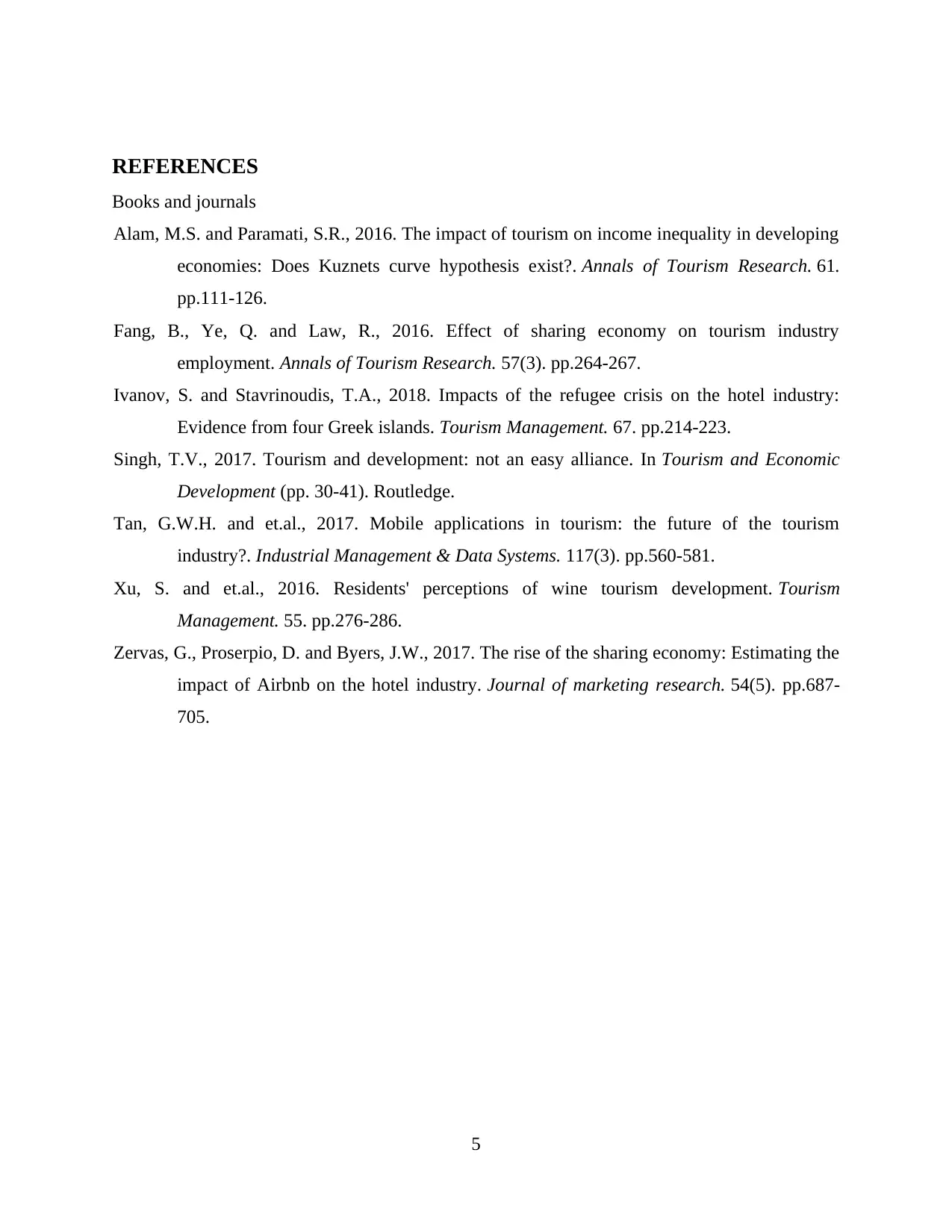
REFERENCES
Books and journals
Alam, M.S. and Paramati, S.R., 2016. The impact of tourism on income inequality in developing
economies: Does Kuznets curve hypothesis exist?. Annals of Tourism Research. 61.
pp.111-126.
Fang, B., Ye, Q. and Law, R., 2016. Effect of sharing economy on tourism industry
employment. Annals of Tourism Research. 57(3). pp.264-267.
Ivanov, S. and Stavrinoudis, T.A., 2018. Impacts of the refugee crisis on the hotel industry:
Evidence from four Greek islands. Tourism Management. 67. pp.214-223.
Singh, T.V., 2017. Tourism and development: not an easy alliance. In Tourism and Economic
Development (pp. 30-41). Routledge.
Tan, G.W.H. and et.al., 2017. Mobile applications in tourism: the future of the tourism
industry?. Industrial Management & Data Systems. 117(3). pp.560-581.
Xu, S. and et.al., 2016. Residents' perceptions of wine tourism development. Tourism
Management. 55. pp.276-286.
Zervas, G., Proserpio, D. and Byers, J.W., 2017. The rise of the sharing economy: Estimating the
impact of Airbnb on the hotel industry. Journal of marketing research. 54(5). pp.687-
705.
5
Books and journals
Alam, M.S. and Paramati, S.R., 2016. The impact of tourism on income inequality in developing
economies: Does Kuznets curve hypothesis exist?. Annals of Tourism Research. 61.
pp.111-126.
Fang, B., Ye, Q. and Law, R., 2016. Effect of sharing economy on tourism industry
employment. Annals of Tourism Research. 57(3). pp.264-267.
Ivanov, S. and Stavrinoudis, T.A., 2018. Impacts of the refugee crisis on the hotel industry:
Evidence from four Greek islands. Tourism Management. 67. pp.214-223.
Singh, T.V., 2017. Tourism and development: not an easy alliance. In Tourism and Economic
Development (pp. 30-41). Routledge.
Tan, G.W.H. and et.al., 2017. Mobile applications in tourism: the future of the tourism
industry?. Industrial Management & Data Systems. 117(3). pp.560-581.
Xu, S. and et.al., 2016. Residents' perceptions of wine tourism development. Tourism
Management. 55. pp.276-286.
Zervas, G., Proserpio, D. and Byers, J.W., 2017. The rise of the sharing economy: Estimating the
impact of Airbnb on the hotel industry. Journal of marketing research. 54(5). pp.687-
705.
5
1 out of 7
Related Documents
Your All-in-One AI-Powered Toolkit for Academic Success.
+13062052269
info@desklib.com
Available 24*7 on WhatsApp / Email
![[object Object]](/_next/static/media/star-bottom.7253800d.svg)
Unlock your academic potential
Copyright © 2020–2025 A2Z Services. All Rights Reserved. Developed and managed by ZUCOL.



